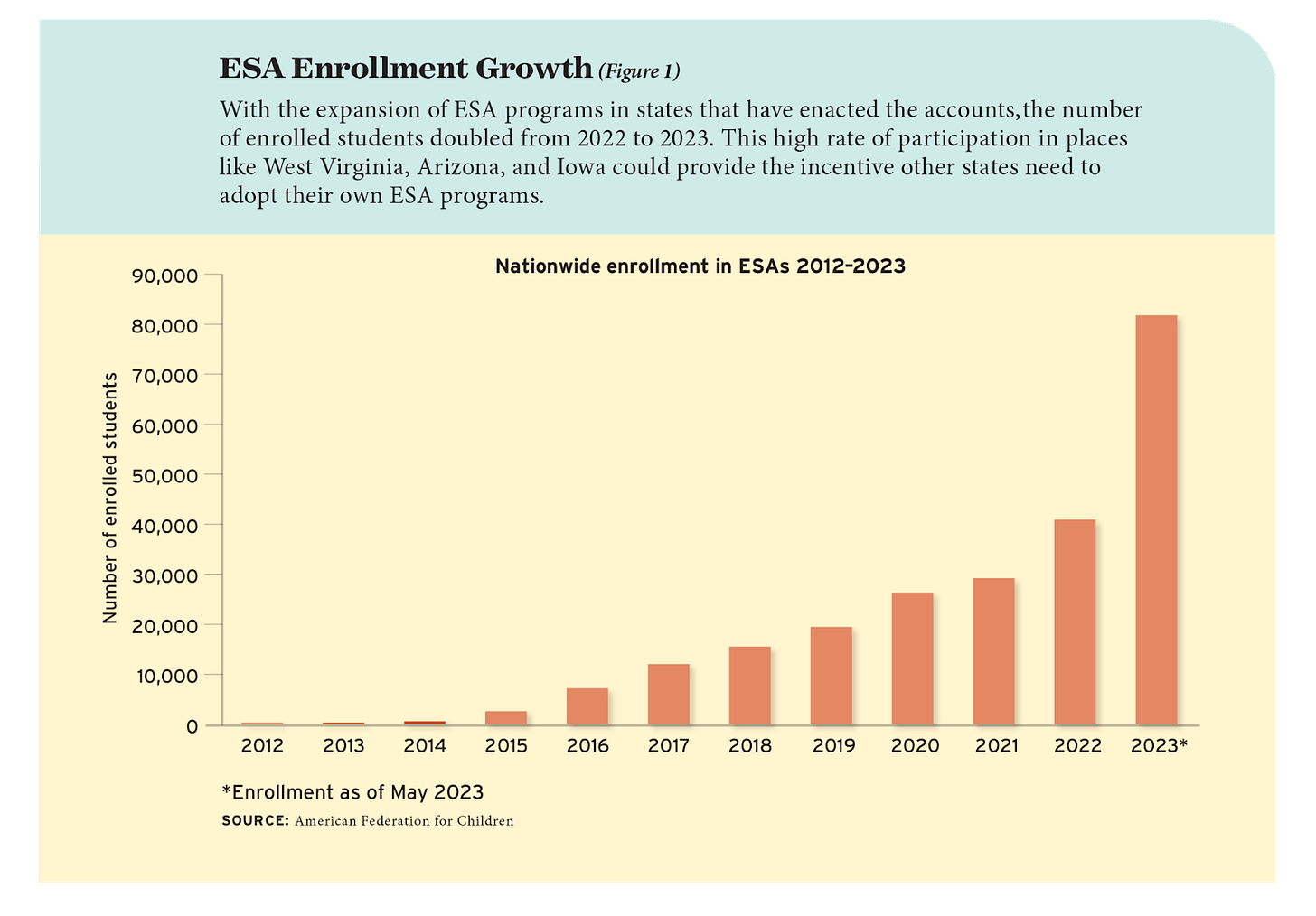1. Teacher Pay Legislation Stalls Nationwide
READ: 25 states have proposed legislation to increase teacher pay this year, but only nine have succeeded. Megan Tagami reported on the legislative debates and how the push for education vouchers has made passing teacher pay increases increasingly complicated:
In Texas, which ranks 28th in average teacher salary, a bill that would have included an estimated $1,200 annual increase for teachers, was stymied in part by debates surrounding school choice.
The bill hit a dead end after the Texas Senate added a provision on education savings account vouchers, which would have offered most families up to $8,000 that could go toward private school tuition or other expenses, according to Zeph Capo, president of the Texas chapter of the American Federation of Teachers union.
Read more in the Wall Street Journal here.
2. Redefining School Improvement
READ: Rick Hess took to the pages of Education Week to reflect on the 40 years since “A Nation at Risk” was published and the way conversations about school improvement have changed:
Instead of more rigor, time, or testing, the most popular proposals tend to be more controversial and more disruptive to familiar routines.
The most popular initiatives today call for fundamentally changing the nature of the traditional schoolhouse:
Charter schooling, education savings accounts, and school vouchers
Calls to shift from traditional courses to mastery-based learning
The embrace of digital devices, remote learning, and AI
The push to overhaul career and technical education
In short, today’s reform agenda features proposals that would fundamentally change that old Horace Mann schoolhouse. It eschews the traditional building blocks of grades, Carnegie units, and time spent in favor of greater personalization, customization, and inventiveness.
Read more here.
3. Restorative Justice Still a Work in Progress in Maryland
READ: Caralee Adams at The Washington Post reported on the implementation of restorative justice practices in Maryland four years after the state passed a law requiring its incorporation in school discipline policies. While research shows restorative justice can have a positive effect, the move has been met with resistance in the face of increased violence and hate-related incidents in some Maryland schools:
In Montgomery County, some parents, teachers and students have pushed back against restorative justice, saying harsher discipline is sometimes necessary to hold students accountable. Others question the way restorative circles are conducted, noting that the circles are often led by staff from the district’s central office, who the students don’t know or trust. They want to see more training, consistency and transparency about the process.
Read more here.
4. HBCUs Prepare for Increase in Applications
READ/LISTEN: The Supreme Court’s recent decision on affirmative action has caused historically Black colleges and universities (HBCUs) to revisit their admissions policies as they prepare for an uptick in applications. HBCUs comprise 3% of colleges but enroll roughly 20% of Black graduates, and the expected increase in applications could challenge the historically underfunded institutions even further:
David A. Thomas, president of Morehouse College in Atlanta, shared similar concerns: “If our applicant pool doubles, we could not double our student body without seriously compromising the quality of our education.” The school is already anticipating a surge in applications — from 6,000 students this year to between 9,000 and 12,000 over the next three years. Thomas did not say if any admissions practices will change but said officials “will have to make sure we continue to admit an economically diverse group of students and continue to serve poor and working-class students” as they sort through large application pools.
Read more from Lauren Lumpkin and Corinne Dorsey in The Washington Post here. Chris and I debated the impact of the Supreme Court’s decision on this week’s episode of Citizen Stewart. Listen here.
5. Wesleyan University Ends Legacy Admissions
READ/LISTEN: Wesleyan University became the latest institution to announce an end to legacy admissions in the wake of the Supreme Court’s ruling on affirmative action. Lexi Lonas at The Hill reported on the University’s statement, which clarified that legacy status has not been a prominent part of its admissions practices for many years:
“An applicant’s connection to a Wesleyan graduate indicates little about that applicant’s ability to succeed at the University, meaning that legacy status has played a negligible role in our admission process for many years,” Wesleyan President Michael Roth said in an announcement.
“Nevertheless, in the wake of the recent Supreme Court decision regarding affirmative action, we believe it important to formally end admission preference for ‘legacy applicants,’” Roth added.
Read more here. We also produced an episode focused on legacy admissions this fall. Listen here.
6. Student Journalism Contributes to Higher Education Transparency
READ: Katie Robertson at the New York Times wrote about the link between student journalism and the recent departures of two prominent officials at well-known universities. Northwestern University fired head football coach Pat Fitzgerald after The Daily Northwestern reported on the team’s hazing practices. Stanford University president Marc Tessier-Lavigne said he would step down from his position after The Stanford Daily triggered an independent review of his research papers. The Stanford Daily’s investigations editor Theo Baker highlighted the role the student publications played in holding the officials accountable:
“More than anything, to me, this should raise conversations about the value of student journalism,” Mr. Baker said. “If you love a place, and I really do love Stanford,” he added, “you want to push it to be more transparent.”
Read more here.
7. ESA Enrollment Doubles
READ: Joseph Olchefske and Steven Adamowski wrote for Education Next about the impact of the parents’ rights movement on school choice and what they define as “the Great Unbundling” of K-12 education:
The traditional K–12 schooling model is a “bundled” product that provides parents with an all-in-one package of services: instruction, transportation, lunch, extracurriculars, and athletics, all delivered by one provider in one location: the school. Historically, parental choice has been limited to selecting from among different schools—neighborhood, magnet, or, for those with the means, private schools. In the 1990s, states started passing legislation that defined school choice in these “whole school” terms, with charters, vouchers, and scholarships providing families with alternatives to schools operated by their local district.
In response to the widespread school closures sparked by the Covid-19 pandemic in early 2020, many parents opted for a pick-and-choose, customized approach to schooling that they hoped could fill gaps in the remote learning opportunities their local districts were providing.
The piece notes the growth of ESAs as a prominent part of the Great Unbundling. As more parents search for options that allow them to feel more involved in their child’s education, ESA enrollment has doubled over the past year:
Read more here.






